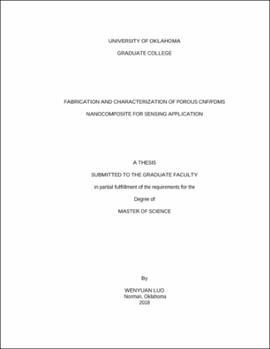| dc.description.abstract | Electrically conductive polydimethylsiloxane (PDMS) elastomer-based materials are growing as one of the critical needs for the emerging field of wearable electronics due to its high elastic limits and good biocompatibility. Recently, researches have shown that the porous structure can further improve its deformability and decrease the concentration of conducive nanofiller loading to easily reach percolation threshold at the same time. To address the challenge of fabricating 3D interconnected conductive PDMS based nanocomposites, this thesis focuses on characterizing material and mechanical properties, and sensing functions of nanocomposites for sensing application. In this study, highly flexible and electrically conductive porous carbon nanofiber (CNF)/PDMS nanocomposites are fabricated by sugar templating strategy and CNF is incorporated by direct and indirect techniques.
The pristine porous PDMS foams with various porosities are synthesized by sugar templating method with different volume ratios of fine and coarse sugar. The mechanical performances, and relationship between Young’s modulus and porosity are firstly investigated under quasi-static compressive tests to select the feasible substrate for sensor design. The Young’s modulus of pristine porous PDMS foam can be properly predicted by a polynomial equation with known density. Then, a series of CNF loadings are deposited in the porous PDMS cube by direct and indirect techniques. Scanning electron microscopy (SEM) is used to examine the morphologies of samples, and the distributions and dispersion quality of CNF. The electrical conductivity of nanocomposites created by the direct and indirect methods are measured. The porous CNF/PDMS nanocomposites created by the indirect method exhibits a lower percolation threshold. The porous CNF/PDMS nanocomposites created by the direct method endow a stronger interfacial adhesion between the CNF and the PDMS polymer. The experimental results under quasi-static compressive test show the concentration of CNF loading can impact the mechanical property (Young’s modulus) of porous CNF/PDMS nanocomposites.
The piezoresistive sensing functions of nanocomposites created by both methods are characterized by correlating the relative electrical resistance change and the compressive strain under cyclic compressive loading and unloading tests at the strain range from 1.25% to 40%. The mechanisms of piezoresistive sensor are responsible for the variation of electric resistance. The tunable sensing performance and gauge factor are depending on the concentration of CNF loading and the fabrication technique. The optimum formulas of porous CNF/PDMS nanocomposites created by both methods are ascertained based on the sensing performances. Finally, the durability and robustness of identified samples are demonstrated. | en_US |
